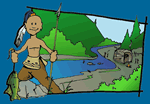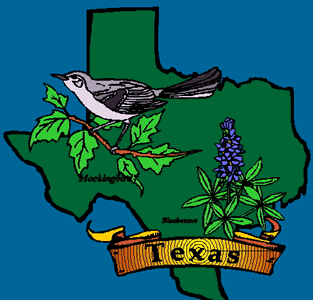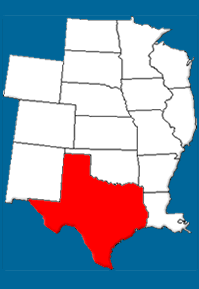


Geography and Landforms:
Texas is the largest of the 48 contiguous states in the U.S. Because of this, it has a wide diversity of landforms. There are six main geographic areas in Texas: East Texas, the Gulf Coast, the Rio Grande Valley, the Blackland Prairies, the High Plains and West Texas.
|
 History:
The first Europeans to visit Texas were from Spain. The Spanish governor of Jamaica gave Alonso Alvarez de Pineda four ships and 270 men, and ordered him to look for gold or other wealth. He and his crew were the first to explore the coast of Texas around 1519. Panfilo de Narvaez, also from Spain, came to the coast of Texas in 1528, having been blown off course in a storm. Four members of his party of exploration survived for nearly seven years in Texas, and it was their reports of the land and native people that led Spain to sponsor Francisco Vazquez de Coronado in his overland expedition through New Mexico and Texas. He reached the panhandle area of West Texas in 1541.
|
 Economy:
Texas leads the United States in its production of oil and natural gas. It is also a major producer of helium, salt, sulfur, sodium sulfate, clays, gypsum, cement, and talc. Texas manufactures an enormous variety of products, including chemicals and chemical products, petroleum, food and food products, transportation equipment, machinery, and primary and fabricated metals. In agriculture, Texas is also a national leader, specifically in the production of cotton, cattle and cottonseed. Texas has more farms, farmland, sheep and lambs than any other state in the U.S. Finally, Texas is an important state in the area of commercial fishing, particularly for shrimp and oysters.
|
 First Inhabitants:
Evidence of human habitation in the area now known as Texas dates back roughly 11,000 years. Archaeologists have found this evidence by looking at several types of sites, including camp sites where people lived; quarries where people cut away stone to use as tools; kill-sites, with evidence of hunters and the remains of their prey, and cave painting sites. For example, a site in Val Verde County, Texas, contains the bones of a large number of bison, along with fragments from the weapons used to kill them and tools used to cut away the meat.This cave dates to nearly 10,000 years ago.
|
Books Related To TexasThe Armadillo from Amarillo - Lynn Cherry The Case of the Measled Cowboy - John Erickson The Crossing - Gary Paulsen Delfino's Journey - Jo Harper A Good Long Way - Rene Saldana L is for Lonestar: A Texas Alphabet - Carol Crane The Legend of the Bluebonnet - Tomie dePaola Messenger on the Battlefield - Melinda Rice Old Yeller - Fred Gipson Pedrito's World - Arturo Martinez Tantalize - Cynthia Leitich Smith The Tequila Worm - Viola Canales |
Famous Citizens:
|
| Capital: | Austin |
| Entered Union: | December 29, 1845 |
| Population: | 26,956,958 |
| Area | 268,581 |
| Bird | Mockingbird |
| Flower | Bluebonnet |
| Nickname: | Lone Star State |
| Governor | Greg Abbott |
Places to Visit in Texas: (Click the links to learn more.)
|



